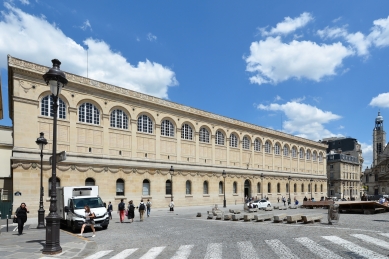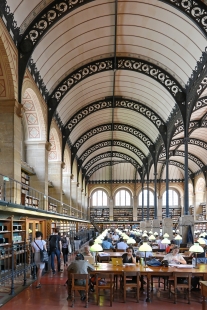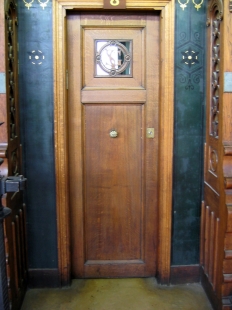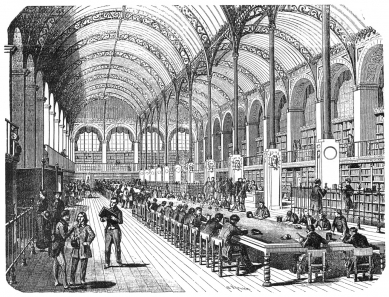
Sainte-Geneviève Library
La bibliothèque Sainte-Geneviève

Another influential example of a 19th century library is the Bibliothèque Sainte-Geneviève in Paris. It was designed in the Neo-Greco style by Henri Labrouste. The library is 282 feet long and 95 feet wide. During this time, railways and iron-roofed rail stations were becoming popular in Europe, along with gaslights. The roof and floors of this library were framed in iron. The iron was not hidden by other material but instead was displayed. Sculpted plinths support the iron columns.
The ground floor is used as storage, so it did not need to have big window. If you look at a picture of the exterior, you will see smaller windows line the walls of the ground floor. To reach the reader room, the user needs to take a stairway to the second floor. Once you reach the top of the stairs, you come across the mural of Raphaels’ School of Athens.
The reading room is the entire length of the building. It is a rectangular space and is lit with big windows on all sides. The room consists of two rows of cast iron arches. Even though it seems like the arches are there to support the structure, it is just for looks. An iron fence separates the books from the users, and the galleries sit on top of the bookcases.
The exterior of the building is especially notable. There are stone panels under the windows. These panels list 810 famous authors.
The ground floor is used as storage, so it did not need to have big window. If you look at a picture of the exterior, you will see smaller windows line the walls of the ground floor. To reach the reader room, the user needs to take a stairway to the second floor. Once you reach the top of the stairs, you come across the mural of Raphaels’ School of Athens.
The reading room is the entire length of the building. It is a rectangular space and is lit with big windows on all sides. The room consists of two rows of cast iron arches. Even though it seems like the arches are there to support the structure, it is just for looks. An iron fence separates the books from the users, and the galleries sit on top of the bookcases.
The exterior of the building is especially notable. There are stone panels under the windows. These panels list 810 famous authors.
0 comments
add comment













































